
winter in Brazil by Amber V. '24
adventures in WGS.245: Race, Place, and Modernity
This IAP, I’ve gone to Brazil!
I’m taking WGS.245: Race, Place, and Modernity. It’s a class focused on Afro-Brazilian and Indigenous Brazilian culture, with tons of readings, movies, and museum visits each week. The class takes place in Sao Paulo, Brazil, so we’re engaged night and day in the setting we’re learning about. I find myself swept up in the intensity, bouncing from adventure to deep discussion and back again. Here’s a taste of what I’ve done.

Sao Paulo is full of murals — we saw this one on the drive from the airport
I managed to pack just one suitcase this time,01 when I went to Denmark, I foolishly brought three and I still filled it with books. This was somewhat easier because it’s summer in Brazil, so I brought mostly shorts and crop tops. I have not had time to open most of the books — I didn’t realize how much time I would invest in this class and the environment.
Each day, we uber to the Brazilian British Center (BBC), a building of white marble surrounded by a mossy moat. There we discuss the day’s readings until 12:30. The readings cover Afro-Brazilian and Indigenous history, culture, forms of resistance and ways of life. There is also focus on Black women and queer narratives.
The class is 20 people, mostly seniors, who are quite knowledgeable about the topics we cover. This is probably the most high-level HASS class I have taken at MIT; our discussions are complex and sometimes intense. I love learning with this group of people, and sometimes feel that I glean as much from a classmate’s perspective on the readings as I did from the readings themselves.
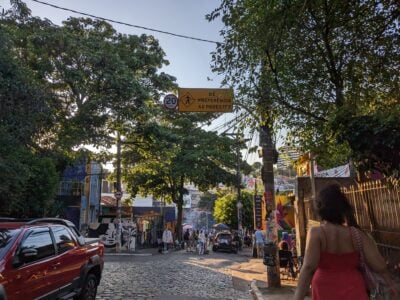
After discussion is over, we have a long break for lunch. We usually split off into groups and explore the restaurants around the BBC. There are a wide variety of cuisines in every neighborhood of Sao Paulo; so far I’ve had Mexican, Thai, Indian, Peruvian, Americanized Italian, and of course many types of Brazilian food. All of the former were less spicy than their counterparts in America. As it turns out, Brazilian food has little spice.
Next we head to a lecture or museum. The variety of museums in Brazil has proven to be truly amazing. Some of my favorites were:
- the Afro-Brazilian Museum, which had pieces from so many time periods and places of the African diaspora. I found some beautiful ironwork from Benin, as well as modern iron sculptures.
- Our guide, Raphaellie, was incredible. She brought us from interpretations of modern Brazilian artists to breaking down and re-structuring colonial narratives in traditional European art.
- Instituto Moreira Salles, a photography museum with an exhibit on Indigenous videography. The videographers were Indigenous youth who were documenting their own communities with the approval and involvement of community elders.
- Pinacoteca de Sao Paulo, a museum which celebrates activism and especially Black activists throughout Brazil’s history. I loved the display of small-press literary zines put together by collectives.
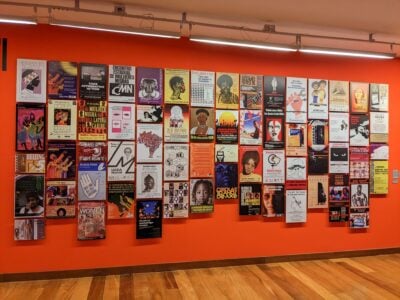
Posters, not magazines, also by collectives and other radical groups
We were also lucky enough to have a lecture and Q-and-A session with Juliana Borges, an activist who fights for prison abolition in Brazil. While Brazil’s mass incarceration differs in some ways from America — for example Brazil has fewer private prisons — the crux of the issue, ie: incarceration as a method for the state to control Black and brown bodies, is the same. I was especially interested in how Borges works both within the governmental system and in groups outside of it to pressure leaders and push for change. I’d recommend her essay “Black Women Under Fire.”
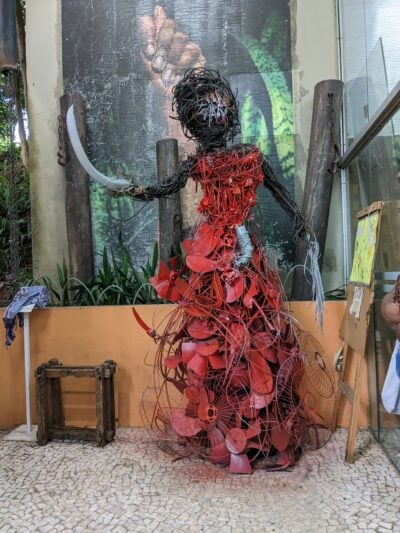
an orixá of the Candomblé religion
In the past two weeks, I’ve absorbed a lot, and I’m still processing. I’ve studied systems of oppression and resistance in my personal life and via MIT classes, namely through a class on the Latinx diaspora and another on race and the environment. I can feel that WGS.245 is pushing my learning further, and I’m grateful for that.
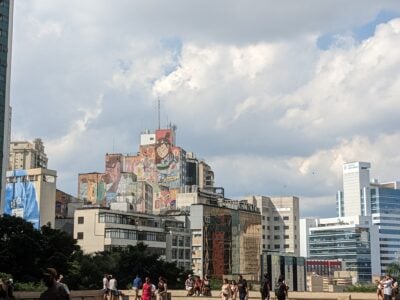
After class, we return to the hotel. I usually either run or crash, depending on the hour. Sao Paulo is an unfamiliar city, and I avoid running after dark.
The night is ours to burn. We usually have a movie and/or a few hours of reading due the next day, so I try to tackle that. My first week, when some friends were in town, I also went out nearly every night. Brazil has an active nightlife, and we’ve romped through a wide variety of venues. By far my favorite trip (though not my favorite location) was when a Brazilian friend of mine asked our Uber driver for recs. Our driver suggested a venue, called his friend for more ideas, and then showed us pictures of his partner, daughter, and dogs. The dogs were corgis.
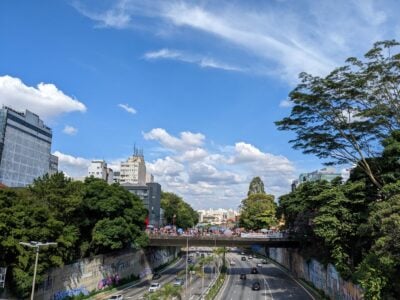
street market in Liberdade neighborhood
We travel everywhere by Uber, since it’s faster and cheaper than the rail system. Drivers in Sao Paulo are in my opinion incredible: it’s a hilly city, and everyone drives stick. The cars are close-packed and tiny, and drivers maneuver into spaces that I would never dare to wriggle into. Traffic lanes are more of a suggestion — once when the highway was empty enough, my driver couldn’t decide which lane to join, so he drove right down the dashed white line between them. Red lights are generally obeyed, but with more leeway than in the US, which I’ve had to be aware of each time I cross a street. My international friend finds all of this entirely normal, but it took me a few days to relax when I get into the front seat.

another mural
When last weekend came around, we went to Rio de Janeiro as a class to visit a few museums and sites. We also stopped by the beach at night — the water was so warm — and wandered through the city. I love the nature all around, the small mountains and patches of jungle.
Before we went back, I ran down the beach, splashing in the water, dodging around couples, groups of friends playing football, and children and their parents. Tourists and locals covered every square foot of beach. I saw the mountainside where there used to be a waterfall, considered the environmental impact of swarms of tourists, as well as the impact of emissions from Brazil and the global north alike. Even so, I was happy to see so many people enjoying the ocean.
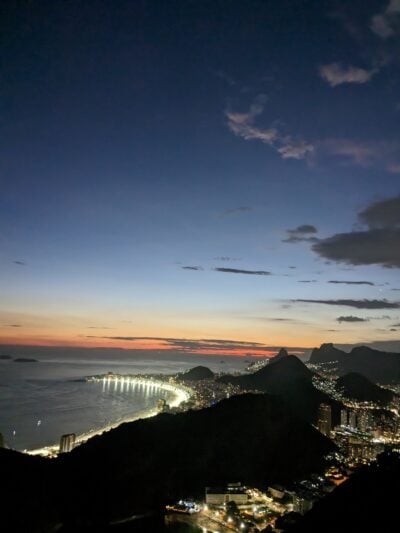
Copacabana beach, Rio, just after sunset
I can’t wait for the next two weeks02 quite fun, so much that I didn't get back to this blog until right now. of Brazil.
- when I went to Denmark, I foolishly brought three back to text ↑
- quite fun, so much that I didn't get back to this blog until right now. back to text ↑









